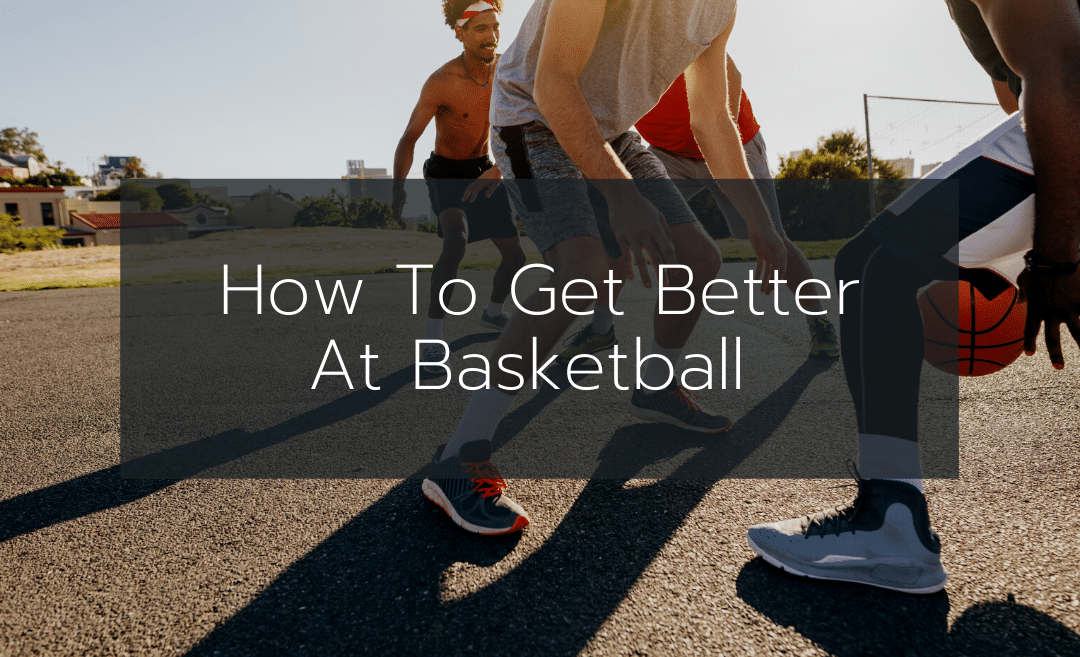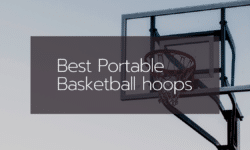Basketball is a beloved sport for millions of people around the world and a unifying point for many communities across all walks of life. From pick-up games on the schoolyard to professionals and Olympians, basketball is a sport many people can get into and enjoy in one way or another.
Basketball is not something that one is naturally great at, and it is not something that can be perfected overnight. Years of practice go into developing basketball skills, and most people who do it on a higher level than pick-up games often say they never stop growing their skills and improving.
Whether you are just starting with a driveway basketball hoop or interested in getting into more serious games, there are plenty of ways to improve how you play basketball. Regardless of skill level, the most important part of all is simply trying your best and having fun. Here is a more complete array of tips and bits of sports to help you improve your basketball skills further.
How To Get Better At Basketball?
The most important thing you can do for yourself as you get better at basketball is to refine the basics and train them until they are instinctual. Bruce Lee once famously said, “I do not fear the man who knows one thousand moves; I fear the man who practices one move one thousand times.” He was talking about martial arts, but the same principle is true for almost anything.
How To Get Better At Basketball Dribbling?
First, we will discuss the basic dribbling and how to do them correctly before moving on to the relatively complicated, power dribbling.
Basic Dribbling
Everyone knows how to dribble; most of us learn in kindergarten gym class. Right? Well, most people learn the basics, but learning how to make the ball come back to your hand and learning the proper techniques to control the ball correctly are two different things.
Proper dribbling can make a major difference in how you move and turn as well as how you line up your shots. Keep your knees roughly shoulder-width apart as you move. Your weight should be evenly distributed on your feet so you can move more readily. Do not lock your knees when you stand; it will make it harder to spring into movements. Try to keep everything as relaxed as you can.
Always stay balanced, both when standing and moving; balance is critical for all of your movements. This is true both for basketball and for any other sport. If you can’t find ways of keeping your balance, you might find yourself tripping over yourself or other players trying to block you.
The ball should not bounce above your waist when you dribble, this is easier said than done, but it is important for control. Keep your wrist moving, so you maintain that control. On defense, you are keeping your body in more of a crouch, so the ball should not bounce above your thigh region.
As basic as dribbling is, it is still something that you should practice as often as possible in the beginning. Practice as often as you can; you can begin developing a sense of how the ball moves in your hand. You need to know how it responds to how much force the ball is under in a given situation. It is also worth practicing your drills with each hand by itself to get comfortable on either side, then learn how to pass between them. You must be ready for any situation that might come up while on the court.
Drills
-
- One dribbling exercise for those just starting is to dribble several times on each side. Start with your right hand, then switch and dribble the same number of times with your left hand. Do a few sets like this to warm up before a practice session and a few more at the end. This one is common in school gym classes, so it may be familiar, but doing it with a purpose changes things.
-
- Dribble in place in the beginning, keeping up good posture with your knees bent and bounce on your toes as if you were about to start moving. When you get used to dribbling while standing still, do this same drill while walking. Finally, start moving faster until you can dribble while running. This teaches your body to develop the coordination to maintain the repetitive motion without you having to think about it.
Power Dribbling
Now that we have covered the most basic of the basics let us take it one step further and talk about the kind of dribbling you will spend most of a normal game of basketball did. Power-dribbling is essentially the run to basic dribbling’s walk.
When you first start practicing seriously, to improve your skills in a meaningful way, your primary goal is simply assuring the ball bounces back close to your hand. Eventually, however, you need to make sure the ball comes back quickly and efficiently and with enough control that you can move gracefully with it and prevent people from taking it from you.
It is all in the wrist, as they say. The key difference between basic dribbling and this is effective wrist movement. To develop a good power dribble, practice bouncing the ball normally before steadily turning up the amount of power you put behind each bounce. It is important not to bounce the ball harder than you can handle, such as so hard you can’t control it, but also not so soft that it doesn’t come back up to you.
When practicing, bounce the ball firmly several times in a row without making your arm fly up to keep control of the dribble, then switch back to a more relaxed dribble. The ball will hit your hand with more force now, but you need to learn to resist it. The next step is learning how to move like that.
Suicide sprints are a great way to get used to these sorts of movements. Run sprints on the court while power dribbling, weaving between cones or other obstacles you have on hand. Dribble from the baseline to the free-throw line and back as fast as possible, maybe even time yourself, then dribble to the three-point line and back.
The important thing is to learn how to maintain control under increasingly high amounts of stress and tighter constraints. You will not have time to think about your dribbling form in the middle of a game; you have bigger things to worry about. Your dribbling needs to just come naturally at that point.
Drills
-
- Dribble in the dirt to practice control and build up strength. The uneven surface means you have to bounce the ball harder than normal to get it to come back at a reliable speed, still consistent enough that you can control it. Once you’re accustomed to doing this while standing still, try walking and then running the way you were with basic dribbling.
-
- Move inside after dribbling on the dirt and dribble like you were prior. You will notice that you have to acclimate to the new lack of resistance all over again; over time, this will teach your muscles to regulate how much force you put into dribbling on their own.
-
- Power dribble a few times with your right hand, then switch over to your left, keeping your speed and force up. These are called power crossovers. Dribble a hard crossover with your left hand back to your right. Rinse and repeat. Later on, you could decrease the number of dribbles before you cross. Make it three, then two, eventually switching back and on every power dribble, then build up speed again.
How To Get Better At Basketball Shooting?
There is a mnemonic device that helps many people remember the fundamentals of shooting a basketball, and it will likely be of some help to you, too, if you do not already know it. The device is BEEFC. Usually shortened to “beef plus C,” and unfortunately, it is not the sort of mnemonic device that spells out a relevant word on its own, but it twists into something memorable. Regardless, this is what it means:
Balance
Before you can do anything, you need to make sure that you have a stable platform to shoot from. Your feet need to be firmly planted on the ground, about shoulder-width apart. Keep your knees relaxed, not firm but also not overly slack. Think of your legs like coiled springs. You should be ready to bound off the ground and jump into the motion.
Eyes
Stare at the basket. Keep your eyes on the rim as you line up the shot shoot. Imagine a coin sitting on the front of the basket and that you are trying to knock it down when you shoot. The ball will go where you are looking, so make sure you are looking at the basket.
Elbows
Keep your elbows tucked as you shoot. Again, think of a coiled spring. Your muscles work best when you think of them as coiled springs. Keep in towards your body when you shoot. Extend your arm from the elbow so that you can…
Follow-Through
Follow the motion through to keep your momentum. Think of it as pushing the ball where you want it to go. Your shooting hand should have an arcing trajectory through the air. To continue the coiled spring analogy, your follow-through is ensuring the force of that spring goes into the back of the ball and propels it in a smooth arch.
Concentration
It is meant to be contrasted with awareness, but an extra A would be too many letters. Quips aside, concentration is the most important part of shooting. You need to zero in on where the ball is going and how you are going to get it there. You have a fraction of a second to make that decision, and it has to be the right one.
Once you have decided to shoot, commit to the shot. Otherwise, the ball will fall short or go wide. The reason why concentration is so important is that it can determine the entire outcome of a game.
When it comes to shooting, it is important to practice more than one type of shooting. Do three-point shots, lay-ups, one-handed shots, everything. More importantly, practice all of them on both sides to build up dexterity and be ready for difficult situations.
The shooting motion is done primarily with the dominant hand and wrist; the rest of the arm just adds power. Practice with that in mind.
When shooting right-handed, your left hand’s purpose is to stabilize the ball as you shoot. It is only there to ensure the ball stays lined up in your right hand. This technique is not great for playing a match with other people, though. In those situations, things are a little more complicated, and a greater amount of versatility is needed.
When it comes to lay-ups, a similar principle applies. A good lay-up hinges on good mechanics and the right overall approach. If your form is solid and you aim correctly, you should make your lay-up without issues. Practicing lay-ups with both of your hands and building up the coordination that comes with it is a great way to make you more versatile as a player.
How To Get Better At Defense in Basketball?
Practicing defense is a little more complicated than the other things we have discussed this far into the guide, mainly because it requires another person on hand to help you. That said, defense is a critical part of being good at basketball in general. It makes you a better team player and helps you both in a group and one-on-one.
The first thing to do is develop your defensive stance. Maintain a wide base with your feet apart and your weight on the balls of your feet and your hips back. Your center of mass should be directly over your center of gravity.
Your arms should stay up and out, ready to intercept incoming passes from your team or the rival at any moment. Do not reach in too much or touch the offensive player if you can avoid it. Doing so will get you called for fouls. Nobody wants that. Your goal is to block and distract the opposing shooter and prevent them from passing.
Not for nothing, but also try not to focus on the opposing player’s stomach or feet. It takes your attention away from where it should be.
The next thing to work on is your shuffle step. The shuffle step is a frequent practice drill that involves moving swiftly sideways back and forth along the length of the court. Often this will be paired with passing balls back and forth to a partner as you go. Both in supervised practices and on your own, train yourself to switch directions quickly by mirroring a teammate’s motions.
Another clever tactic is to use your feet to block an opposing player’s pass. To be clear, do not trip anyone. That will get you fouled. What you do is push the opposing player toward the side by putting your lead foot in between them and the hoop. Now, if they come down the middle, you can push him left by leading with your right foot. Outside of defending at the moment, these are the kinds of moves that thwart entire offensive plans.
Passing
This is all well and good for being able to handle the ball well. You will probably do just fine playing one-on-one with the advice we have given you so far. But so far, we have said little about being a better basketball team player. The first step to that is knowing how to work together more effectively, and the first step to that is knowing how to pass.
This may seem like an obvious thing to talk about, but making clean and direct passes can be the difference between a bunch of people playing basketball and a real team. Even if you are all talented on your own, learning to work together is important to succeeding on the court. Team drills go a long way to make you and your team better.
Drills
-
- Pantomime a fast break. With five people, move down the court without letting the ball touch the floor in any way or moving with the ball. All you have now is passing. This is all about speed and precision..
-
- Play “hot potato.” This one is pretty self-explanatory. Have someone turn some music on and off in random intervals. Whoever is holding the ball, in the end, is out. The game teaches you to pass quickly and effectively without dribbling and teaches you to aim and throw quickly when you get it.
Frequently Asked Questions
Here are the answers to some of the frequently asked questions we came across while putting together this article.
A jump rope is your best friend. It helps improve your body’s vertical leap, it increases your stamina and works your heart and lungs, and it strengthens your legs. Other things may help with specifics, but a jump rope helps with everything.
Mindset. We can go on and on about the drills you can do and the skills to learn, but only you know the strengths and weaknesses that you have, and only you can improve on them. Be a student of the game first and foremost.
Form is important because it makes it so you can do what you need to do reliably. Anyone can get lucky and shoot well on accident, but form can make it, so you know how to shoot that well every time and assess where you need to get yourself so you can do it.
Conclusion
A lot of hard work goes into developing skills with any sport. Basketball is all about coordination and decision-making. It is about knowing what to do and when to do it and acting on it quickly and effectively. We hope this was helpful and informative to everyone.





